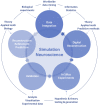A Brief History of Simulation Neuroscience
- PMID: 31133838
- PMCID: PMC6513977
- DOI: 10.3389/fninf.2019.00032
A Brief History of Simulation Neuroscience
Abstract
Our knowledge of the brain has evolved over millennia in philosophical, experimental and theoretical phases. We suggest that the next phase is simulation neuroscience. The main drivers of simulation neuroscience are big data generated at multiple levels of brain organization and the need to integrate these data to trace the causal chain of interactions within and across all these levels. Simulation neuroscience is currently the only methodology for systematically approaching the multiscale brain. In this review, we attempt to reconstruct the deep historical paths leading to simulation neuroscience, from the first observations of the nerve cell to modern efforts to digitally reconstruct and simulate the brain. Neuroscience began with the identification of the neuron as the fundamental unit of brain structure and function and has evolved towards understanding the role of each cell type in the brain, how brain cells are connected to each other, and how the seemingly infinite networks they form give rise to the vast diversity of brain functions. Neuronal mapping is evolving from subjective descriptions of cell types towards objective classes, subclasses and types. Connectivity mapping is evolving from loose topographic maps between brain regions towards dense anatomical and physiological maps of connections between individual genetically distinct neurons. Functional mapping is evolving from psychological and behavioral stereotypes towards a map of behaviors emerging from structural and functional connectomes. We show how industrialization of neuroscience and the resulting large disconnected datasets are generating demand for integrative neuroscience, how the scale of neuronal and connectivity maps is driving digital atlasing and digital reconstruction to piece together the multiple levels of brain organization, and how the complexity of the interactions between molecules, neurons, microcircuits and brain regions is driving brain simulation to understand the interactions in the multiscale brain.
Keywords: brain modeling; brain structure and function; connectome; digital reconstruction; history; neuronal types; simulation neuroscience.
Figures
References
-
- Abbe E. (1873). Beiträge zur theorie des mikroskops und der mikroskopischen wahrnehmung. Arch. Mikrosk. Anatomie 9, 413–418. 10.1007/BF02956173 - DOI
-
- Alzheimer A. (1906). Über einen eigenartigen schweren erkrankungsprozeβ der hirnrinde. Neurol. Central. 23, 1129–1136.
Publication types
LinkOut - more resources
Full Text Sources
Other Literature Sources






